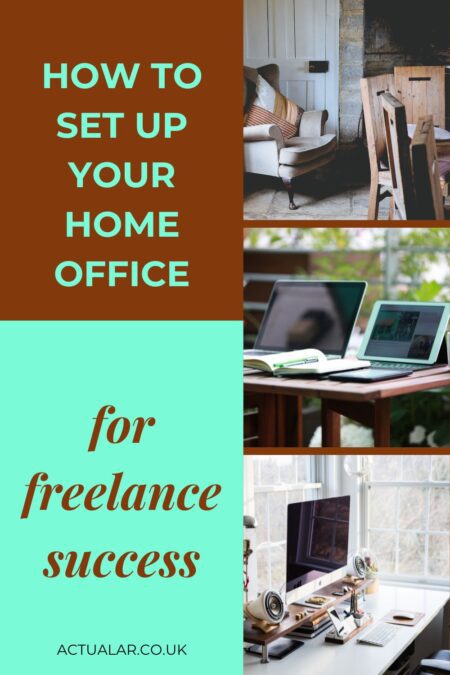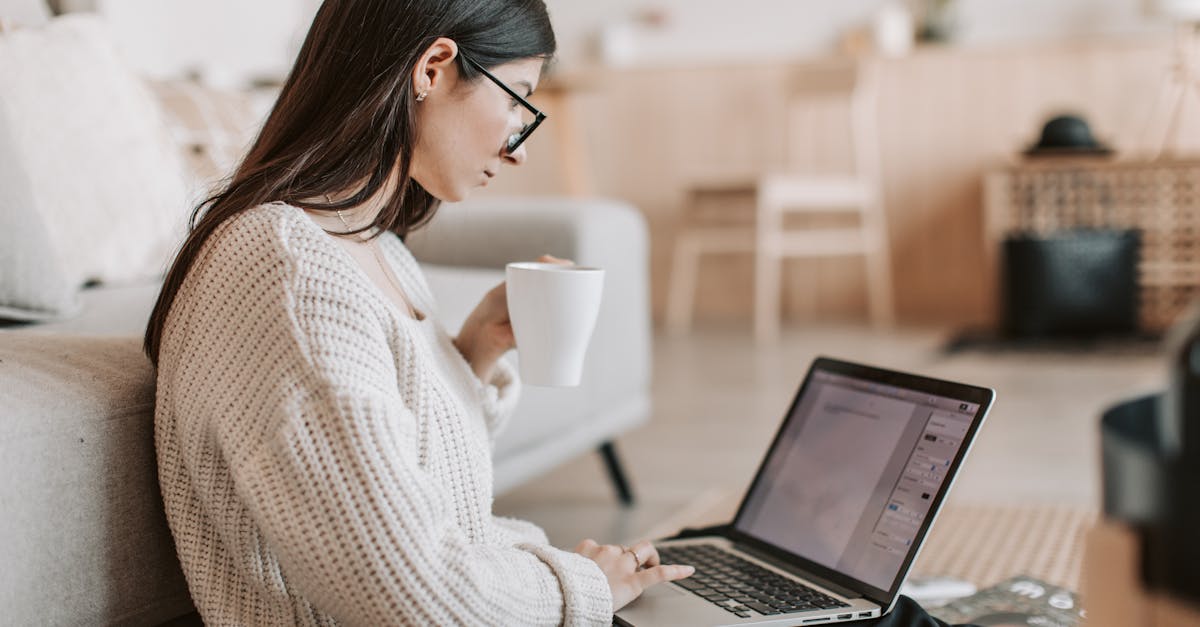When starting out as a freelancer and working from home, you’ll need to take some time to set up your home office, because you’ll need one. One of the things that are most important, in my opinion, to getting started on the right foot with freelancing, is having your own home office space. It can make a big difference.
Although many people are happy working from anywhere with just a laptop and a to-do list, I work better in a dedicated space. It’s all done to personal preference, of course. However, in this post, I’m going to explore how to set up your home office, as I believe it’s one of the key steps you can take to make a success of your first year in freelancing.
It’s important to remember that what works for me may not work for everyone. If you find that you’re more productive in a distraction-free zone, then read on for some top tips for getting started with creating your own workspace. I’ll include some affiliate links to items that might help create the perfect space.
There are lots of ways that you can create a home office in your own house, even if you feel like you don’t have much space to work with. Carving out a little area for yourself is really important, no matter which room of the house you might be in. Yours might even be in a shed out in the garden! Ultimately, setting yourself up for success in a home office space is about doing whatever works best for you.
Let’s jump into a few of the reasons that setting up a home office is so useful for freelancers or anyone who wants to make a real go of their self-employed business.
Why and how to set up your home office
First and foremost, it’s important to remember that everyone learns and works differently. I’m the kind of person who’s at their most productive when working alone. In general, I find that when I have space and quiet to organise my thoughts, I can be a lot more productive than if I were trying to work in a shared environment. Keeping on top of your wellbeing is crucial when you’re trying to manage your own self-employment. So, having the right space to do that matters.
I’ve worked in my own home office and also in a shared office hub in the city, where hotdesking was the name of the game. A lot of freelancers really thrive in this kind of environment, but I found it challenging. Nothing in the office really felt like my own and having to swap desks on different days and just work anywhere really messed with my workflow.
For me, a static space I can carve out as my own is important, because it helps me settle into a more productive routine. I find that in my own home office, I can focus on the granular details of what I need to achieve, rather than feeling out of sync with my surroundings. My home office allows me to ignore whatever is going on externally and focus exclusively on my work.
What should a home office look like?
Obviously, not everyone has the space in their home for a dedicated office. However, there are still ways to create your own ‘home office’ workspace. There are no hard and fast criteria for home offices or workrooms. Try to work out which space or area in your home allows you to feel the most relaxed or detached from the rest of your surroundings.
I say detached because to make this home office setup work, it needs to feel like you’re not just at home. Drawing the boundary between home life and work life is incredibly important as a freelancer. It’s very easy for the lines to become blurred when you work from home, so set yourself some strict rules from the off and you’re much more likely to see results.
I have an attic workroom that I’ve designated as my home office. It’s light and spacious enough for me to fit a desk and drawing table in. More importantly, it’s at the top of the house, away from the noise of home life downstairs. Find your space and see what you can do to segregate it from the rest of your home. Even if that just means closing the door.

What should I include in my home office space?
At the bare minimum, get yourself a table or desk and a comfortable chair. I find that if I’m sitting up and working at a desk, I always get more done. I’ve tried working from the couch or my bed, but it just doesn’t have the same effect for me.
Treat your work like work. That’s the only way I can think to explain it. If you allow yourself to work sloppily, your work may end up sloppy as a result. Take your office seriously. Treat it as if you were going out to work and had arrived at the office.
I’m not saying you need to go the full hog and wear formal attire to your own home workspace, but take it seriously and show up. You may be surprised at how much you actually accomplish.
Aesthetics and tone
Ensure your home office is furnished attractively but with as few distractions as possible. You want your home office to feel comfortable but purposeful. Although it’s a space in your home, you’re there to get stuff done. A minimal feel can help to focus your mind and concentrate your efforts.
Having said that, there’s no reason you can’t decorate your home office space with useful and visually appealing items. Think about the overall aesthetic you want for your space and aim to create something that’s in keeping with your vision. Even if your workspace is just in a corner of your bedroom, try to find a way to distinguish that area. Maybe use different lighting, or add plants around the desk. Whatever works for you!
Also, try and make sure you’re near a window, or that there’s plenty of natural light coming into your office room. This helps enormously.
What about furniture?
So you’ve got your desk, a chair, probably a computer and some gadgets. But what else should you look for? If you have enough space, I’d recommend getting shelves or a bookcase of some sort. You’ll need somewhere to organise your folders and paperwork.
Now that you’re self-employed, record-keeping is going to be very important. You’ll need to organise your bank statements, expenses, receipts, invoices and all sorts of other documents. Despite most record-keeping being done digitally, it’s still important to have a system in place for physical paperwork.
I organise any paperwork into tax year-appropriate folders, which I then store in a bookcase. It just makes life a lot easier when it comes to locating information for accounts and self-assessment. Organise your paperwork and store it all somewhere you can access it easily.
Additionally, find a way to arrange all your tools and work materials, particularly if you have a business that deals in physical products or merchandise. If you’re an artist, for example, you’ll need to set up a table space or workstation for crafting and creative work. The same goes for stock and storing packaging. Invest in some good-quality storage solutions and arrange them in your home office space so that it feels professional as well as presentable.
Artwork and mood lighting for your walls can also help. Having a cosy interior space to work in is important when everything turns cold and dark in the winter.

What else to consider when setting up your home office?
Establish some kind of schedule. This might be as simple as closing the door and informing your family that under no circumstances are you to be disturbed during working hours. However, in reality, this isn’t always possible, especially if you have kids at home.
Try to work out some ground rules and a timetable for yourself. Discuss these with the other members of your household too. They’re far less likely to disrupt you if they’re aware of your working pattern.
Be realistic about how much time you’re going to actually spend in your home office. If you’re going to be in there for hours at a time, make sure you invest in good quality, long-lasting furniture, particularly the chair you’ll be sitting in. This is really important and probably one piece of furniture that’s really worth investing some thought and potentially spending into.
Ensure any tools or important equipment are stored away safely as well, particularly if you’re in a room that others use. I’ll never forget coming upstairs to start my day one morning and finding that my child had been playing with my ridiculously expensive ink markers because I’d left them out the night before. Never again.
Exercise and take regular breaks
Make sure you pencil in time for breaks and exercise. One of the things that most often gets overlooked when working from home is the need to stretch those legs! Leaving the desk and doing a ten-minute yoga stretch, for example, is a good way to keep the mobility in your hamstrings and back after hours of sedentary time.
Remember to also take a break for lunch. It’s often tempting to just power through once you’re in the work zone, but try to step away when you need to eat. Also, ensure that your home office is kept tidy and respected by all the members of your home. If you’re using a shared space, remember to tidy up after yourself once you’ve finished your working day. That way, you can ask the others who use it to show you the same courtesy.
What will your home office look like?
Setting up a home office is a key step on the road to fully managing your self-employed career. It may need some thinking about, but there’s bound to be at least one area of your home that you can block off for yourself for a little while each day. Get creative with it if needs be. A friend of mine upcycled a large wardrobe to turn it into a desk workstation in her bedroom that she could sit at and then put away, for example!
As a freelancer, it’s so important to carve out your own professional identity, and setting up your own home office space is one way to start doing that. Remember, your home office needs to be your space – somewhere you feel at your most productive. Don’t worry about making it look perfect, just make sure it’s yours.
I’d love to hear your thoughts on this topic, especially if you work from home too. Have you managed to create your own home office? How did you go about getting it set up? If you have any tips or further advice that you think would be useful to fellow freelancers then leave a comment below.
If you’ve enjoyed this post or found it useful then please do give it a share or pin it to your Pinterest boards. You may also be interested in reading some of my other posts on getting started with freelancing.




